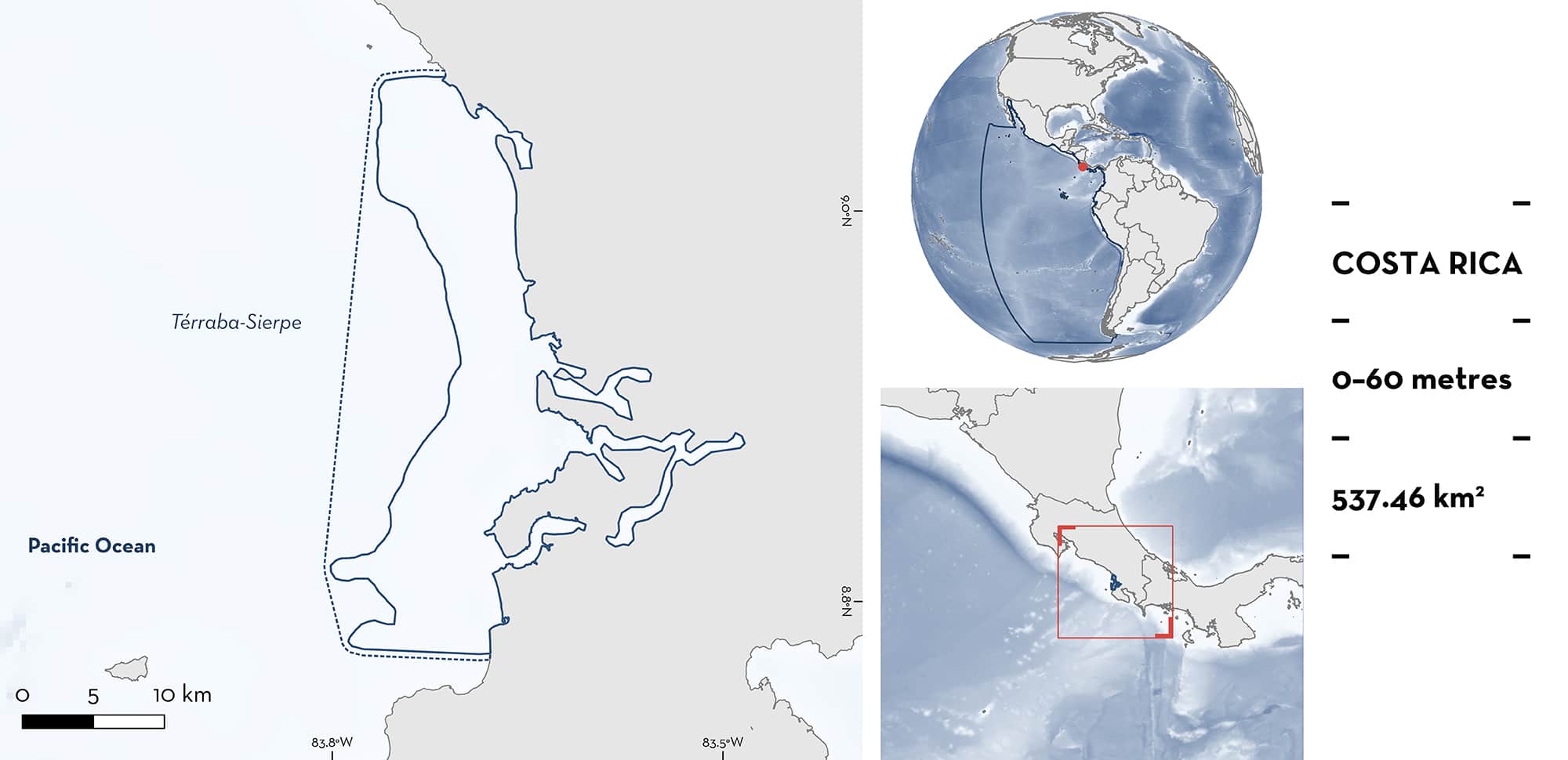ISRA FACTSHEETS
ISRA FACTSHEETS
CENTRAL AND SOUTH AMERICAN PACIFIC REGION
Térraba-Sierpe
Summary
Térraba-Sierpe is located on the southern Pacific coast of Costa Rica. This productive area includes the Humedal Nacional Térraba-Sierpe, one of the largest wetland systems in Central America, a Forest Reserve, and a Wetland of International Importance (Ramsar site). This area is characterised by important coastal and estuarine habitats. Its productivity is influenced by the rainy season which increases river flow, nutrient input, and primary productivity. Within this area there are: threatened species (e.g., Largetooth Sawfish Pristis pristis); range-restricted species (e.g., Pacific Chupare Styracura pacifica); reproductive areas (e.g., Brown Smoothhound Mustelus henlei); and this area sustains a high diversity of sharks (18 species).
Download factsheet
Térraba-Sierpe
DESCRIPTION OF HABITAT
Térraba-Sierpe is located on the southern Pacific coast of Costa Rica along the coast of Puntarenas. Situated within the Pacific Central-American Coastal Large Marine Ecosystem (LME), the area includes the Humedal Nacional Térraba-Sierpe and a large portion of coastal waters from 0–60 m depth. The Humedal Nacional Térraba-Sierpe, one of the largest wetland systems in Central America (267.8 km2), was designated as a Forest Reserve in 1977 and declared a Wetland of International Importance (Ramsar site) in 1995. The rainy season spans from May to December and contributes up to 4,000 mm of annual rainfall, thus increasing river flow, nutrient input, and primary productivity within this area. The mangroves which characterise this area contribute to its international importance as a wetland (Piedra et al. 2019).
This Important Shark and Ray Area is delineated from surface waters (0 m) to a depth of 60 m based on the maximum depth range of the habitat used by the Qualifying Species.
CRITERION A
VULNERABILITY
Fourteen Qualifying Species considered threatened with extinction according to the IUCN Red List of Threatened Species™ regularly occur in this area. Threatened sharks comprise one Critically Endangered species, three Endangered species, and three Vulnerable species; threatened rays comprise one Critically Endangered species, and six Vulnerable species (IUCN 2022).
CRITERION B
RANGE RESTRICTED
Térraba-Sierpe holds the regular presence of Chilean Torpedo, Southern Banded Guitarfish, Longtail Stingray, and Pacific Chupare as resident range-restricted species. These species regularly occur in the area as observed from fishery-dependent and independent surveys (Clarke et al. 2011; Espinoza et al. 2013; Clarke et al. 2014; Clarke et al. 2016; Clarke et al. 2018; Azofeifa-Solano et al. 2021; Clarke et al. unpubl. data 2022; Espinoza & Valerio-Vargas, unpubl. data 2022). All these species primarily occur in the Pacific Central-American Coastal LME. Chilean Torpedo and Southern Banded Guitarfish also occur in the Humboldt Current LME. Longtail Stingray occurs in the Pacific Central-American Coastal LME and the Gulf of California LME.
CRITERION C
SUB-CRITERION C1 – REPRODUCTIVE AREAS
Térraba-Sierpe is an important reproductive area for eight shark and five ray species.
Large numbers of neonate and juvenile Scalloped Hammerhead, Brown Smoothhound, and Sicklefin Smoothhound are captured in river mouths and coastal areas within this area according to fishery-independent trawl survey data (2009–2012) and fishery-dependent landing data (2013–2016) (Clarke et al. 2011; Clarke et al. 2014; Clarke et al. 2016; Clarke et al. 2018; Clarke et al. unpubl. data 2022).
Large numbers of neonate and juvenile Pacific Sharpnose Shark, Blacktip Shark, Longtail Stingray, and Whitenose Shark are captured in coastal areas within this area, according to landing data (2013–2016) from fishery-dependent and independent surveys (Clarke et al. 2011; Clarke et al. unpubl. data 2022).
Fishery-independent trawl survey data (2009–2012) indicate that large numbers of neonate and juvenile Rasptail Skate and Southern Banded Guitarfish are captured in coastal areas within this area, and Pacific Guitarfish and Chilean Torpedo are captured in deeper areas (50–60 m) (Clarke et al. 2011; Clarke et al. 2014; Clarke et al. 2016; Clarke et al. 2018; Azofeifa-Solano et al. 2021; Clarke et al. unpubl. data 2022).
Fishery-independent surveys (2017–2019) and fishery-dependent landing data (2013–2016) indicate that neonate and juvenile Bull Sharks are observed, and presumably use this area as a nursery ground (Clarke et al. unpubl. data 2022; Espinoza & Valerio-Vargas, unpubl. data 2022).
Térraba-Sierpe has also been recognised as a hotspot for Largetooth Sawfish. Fishers were interviewed to gain knowledge about sawfish sightings in the region, with a focus on Costa Rica. They noted that recent sawfish sightings (<5 years) were more common in this area than in other areas of Costa Rica (Valerio-Vargas & Espinoza 2019) with records and photographs of juvenile, sub-adult, and adult Largetooth Sawfish (M. Espinoza pers. comm. 2022). This is supported by local ecological knowledge, capture reports, and museum records of small sawfish captured in several locations within this area (Chicas-Batres 1995; Angulo et al. 2013; Valerio-Vargas & Espinoza 2019).
Despite the relatively low density of captures/sightings, the fact that this area sustains this species at various life stages is particularly significant considering their local extinction from much of the Eastern Pacific (Kyne et al. 2013; López-Angarita et al. 2021).
CRITERION D
SUB-CRITERION D2 – DIVERSITY
Térraba-Sierpe sustains a high diversity of Qualifying Species (18 species). This exceeds the regional diversity threshold (17 species) for the Central and South American Pacific region.
Download factsheet
SUBMIT A REQUEST
ISRA SPATIAL LAYER REQUEST
To make a request to download the ISRA Layer in either a GIS compatible Shapefile (.shp) or Google Earth compatible Keyhole Markup Language Zipped file (.kmz) please complete the following form. We will review your request and send the download details to you. We will endeavor to send you the requested files as soon as we can. However, please note that this is not an automated process, and before requests are responded to, they undergo internal review and authorization. As such, requests normally take 5–10 working days to process.
Should you have questions about the data or process, please do not hesitate to contact us.


